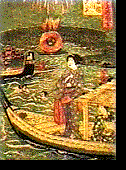

In the latter half of the 17th century, "Yakata" boat outings on the Sumida River were the ultimate luxury for feudal lords. The first displays on the river consisted of fireworks which were paid for by customers on the boats. In 1732, there was a serious food shortage due to crop failures, and a cholera epidemic resulted in many deaths. The next year, Yoshimune, the Shogun at that time, ordered a large fireworks display to console the spirits of the deceased. This was the beginning of the fireworks display tradition on the river.
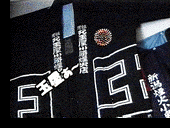
Even today in Japan, during a fireworks display, you hear people shout Tamaya!... Kagiya! These are the family names of two famous pyrotechnicians who played a major role in the development of fireworks in Japan. Yahei Kagiya set off 20 bursts during the first Ryogoku river festival in 1733. They were so spectacular that he became famous all over old Edo, and the festival became an event that people looked forward to all year. Originally an apprentice to Kagiya, Tamaya began competing with Kagiya in 1810. From this time on, there was a yearly competition between the two, with Tamaya setting off fireworks from an upstream boat, while Kagiya was in a boat some distance downstream. Tamaya caused a fire in 1843 which burned a substantial part of the city, and was expelled from the city. Although the competition between the two men only lasted 32 years, the names are still used by people today to express their thrill at seeing a spectacular fireworks display.
Red, Blue and Green (1st Innovation)
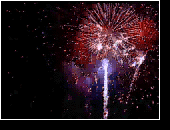
Japanese culture opened up to the world after the Meiji Restoration. Until that time, the only raw material available for fireworks was black gunpowder made from potassium nitrate, sulfur and charcoal. Therefore, the only color that could be created was red. However, more trade with other countries led to the import of potassium chlorate, used to make matches. This was followed by the import of barium nitrate, aluminum nitrate and magnesium nitrate and other raw materials for fireworks, enabling Japanese pyrotechnicians to add blue and green to their displays. This signalled the advent of modern fireworks in Japan.
Night Fireworks Commemorating Imperial Constitution
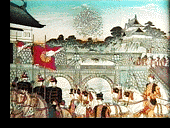
Feb. 11, 1889 was the date of the proclamation of the imperial constitution of Japan, and one big festival was held all over Tokyo. A huge fireworks display was set off in front of the Imperial Palace.
Small Flowers Scattered Across Night Sky (2nd Innovation)

By the beginning of the Taisho era in 1913, pyrotechnicians succeeded in creating bursts which opened up evenly. When a large number of these were set off consecutively, they had the appearance of many small flowers blooming, and the spectators clapped in appreciation. This represented the 2nd innovation in fireworks, and led to many further innovations.
Many Experts in the Making of Fireworks
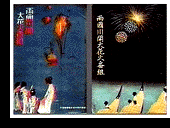
During the Taisho and Showa eras, many famous pyrotechnicians left their mark on the history of firework development in Japan.
Each and every one did his best to create an effect of which no other pyrotechnician was capable.
World's Best Fireworks! (3rd Innovation)
The development of titanium for use in fireworks ushered in the 3rd age of firework innovation. Many new types of fireworks made their appearance, but some were not immediately liked by the people. They gradually gained acceptance, and fireworks displays continued to become more beautiful and spectacular. Japanese fireworks are among the best in the world today, and are exported to some 24 countries around the world.
"Star Mine" Rapid Succession Display
The term "Star Mine" was created in Japan to refer to a spectacular fireworks display in which several hundred bursts are set off in rapid succession. The sight and sound of one of these displays always leaves the spectators in awe. The first such display, entitled the "Chrysanthemum Field," was put on in 1877.

Today, fireworks are controlled by computer, in contrast to the past where pyrotechnicians ran from one fuse to the next, setting off each burst. This advancement has enabled a larger number of rapid succession bursts than possible before. Some contemporary displays combine fireworks with a laser show.